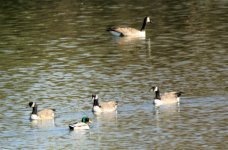Seen on Nov. 12, 2016 on a small pond near a shopping center in northern Delaware. The size is clearly smaller than most of the Canada geese in the pond, including the one in the background, and not a lot larger than the Mallard. The necks seem relatively short and thick and the forehead relatively steep. I am not sure the bills are stubby enough gut I an leaning toward Cackling Geese.
-
Welcome to BirdForum, the internet's largest birding community with thousands of members from all over the world. The forums are dedicated to wild birds, birding, binoculars and equipment and all that goes with it.
Please register for an account to take part in the discussions in the forum, post your pictures in the gallery and more.
Cackling or Canada Goose in Delaware, USA (1 Viewer)
- Thread starter GTeig
- Start date





